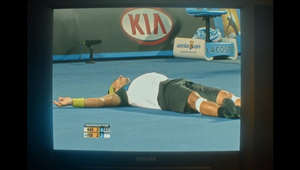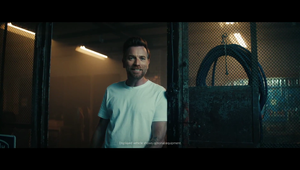
5 Commercial Touchdowns from David McNally’s Super Bowl Playbook

CoMPANY Films director David McNally has achieved success at the Big Game that few others have. Five ads that he’s directed for gameday spots have made it into USA Today’s annual Super Bowl AdMeter Top 5.
“My experience is somewhat unique,” he tells LBB’s Ben Conway, “in that most of those spots were for Budweiser or Bud Light. They were a terrific client.” Budweiser was the client for four of the five ads; namely Budweiser’s spots ‘Lobster’ and ‘King Crab’, and Bud Light’s ads, ‘Secret Fridge’ and ‘On the Roof’. The fifth was ‘Rabbits’ for Visa.
He describes Budweiser’s Super Bowl approach during those years as a kind of elimination tournament - unintentionally mimicking the NFL playoffs leading up to the Super Bowl – with many spots from different creative teams being approved and feeding into a competition to decide which would air. “It felt more like a team challenge, with all of us trying to make our commercials the best they could be,” he says.
“As a result, it was weirdly more like camaraderie than pressure… Who will win? [It’s a] pretty smart strategy either way.” More recently, Doritos has adopted a similar approach, but instead sources fan-made videos to battle it out for Big Game airtime.

Above: David McNally directing
For all of the Budweiser spots, David worked with “incredible creative teams” at DDB Chicago, an outfit that protected his ideas so he could focus on simply making the spots great. “I never felt pressure from the Budweiser client either,” he adds, explaining that the success of ‘Lobster’ – the first spot he did for the brand – and his subsequent spots with them, bought him “an enormous amount of trust” that he would deliver on the biggest stage.
Looking back at his Big Game debut, he says, “We shot ‘Lobster’ in Toronto in late December. While we were shooting in the restaurant, it started snowing. It turns out this was one of the biggest snowstorms of all time in Toronto. They shut the city down and even called in the civilian support division of the Canadian armed forces.
“As was customary with the client, we were to shoot multiple endings to the spot, not knowing which would make it into the commercial. One involved the lobster sitting in the back seat of a cab with the stolen Bud… But when it came time to shoot, it was completely covered with snow up to the roofline. We had to dig a path to and around the cab to even get the shot. A shot that was funny, but never made it into the finished spot!”
From the very beginning, David says he knew instinctively that the comedy needed to work without sound. “People love watching Super Bowl spots but often they’re at a bar or a party where, during the commercial breaks, people are talking, laughing and shooting the breeze about this or that play, or (ahem) a referee call… So the spots have to be funny even if you can’t hear. You have to visually get the gag.”
This contrasts with the director’s usual approach, which more often uses misdirects and an unassuming, subtle set-up, before a rug-pull punchline. “I actually remember watching ‘Lobster’ in a local bar. You couldn’t hear the sound of the TV at all. But people were laughing and pointing at the screen anyway, so I knew it would score well. I’ve stuck with that instinct for every Bowl spot I’ve done since, and it always seems to bear out.”
However, he notes that the ‘sound-off’ philosophy can be misconstrued. “Some people interpret this as meaning the spots have to be slapstick or over the top. Those don’t tend to appeal to me. Super Bowl spots can be visually arresting but still smart. Those make me laugh the most. And of course animals… be they real or imaginary, those always work.”
David found animal-based success again with Budweiser, staying in the realm of crustaceans. ‘King Crab’ featured a beach full of the critters who mistake a Budweiser cooler for their overlord – but delays with the CGI meant it nearly didn’t make the broadcast.
“As a result, it was placed very late in the game,” says David. “Traditionally, spots do better when they come in the first half, and ‘King Crab’ was in the final quarter. Lucky for us, it was an extremely close game that came down to the wire, so people were watching intently right up until the end! And ‘King Crab’ placed number one [in the USA Today’s Top 5].”
He shares that timing is always really tight, when it comes to the Super Bowl; decisions are often made very close to the network deadlines. “There’s a lot of last minute scrambling to get things done in time for editing, submitting to the client, preliminary testing, etc. Throw in the inevitable last minute creative tweaks and changes, and it gets even more hairy.”
This is only magnified when working on multiple spots, as David discovered in 2006 when he directed a package of four Bud Light ads. Two of these, ‘Secret Fridge’ and ‘On the Roof’, both made it into USA Today’s Top 5 in the same year.
Working with two different creative teams, both intent on winning Budweiser’s selection for the Big Game, David had a challenge on his hands to balance preproduction time. “But as someone who thrives under pressure,” he says, “it's really just an opportunity to figure out the puzzle pieces and get things done in the best possible way, in the time allotted.”
A final spanner in the works arose when David got to the ‘Secret Fridge’ set and realised the art department had misunderstood his directive, fashioning an entire revolving wall in the apartment set, instead of a revolving fridge. “It was an amazing engineering feat, but totally wrong - and strangely not what was depicted on my storyboard,” he recalls. “But like troopers, they stayed up all night cutting the set walls and re-engineering the revolving platform to make it right by call time the next morning. [An] incredible effort for another number one spot.”
David would return to the animal kingdom for his Visa commercial, ‘Rabbits’ – a film neither he nor the BBDO NY creative team expected to be a Super Bowl contender during shooting. While busy prepping for a film shoot, the director actually missed the Big Game that year and didn’t find out about the AdMeter success until several years later.
“All the rabbits were real. It was before CG could make animals with convincing hair,” he explains. “We had over 200 rabbits that we placed around the set and composited it all together in post. It took a long time to wrangle rabbits and move them around to camera. Not that I was a part of it, but I heard the rabbit dropping clean-up was legendary.”
He adds, “This spot was one of several I shot with the late, great cinematographer Allen Daviau, who was a genius - having shot, among others: ‘E.T.’, ‘The Color Purple’, ‘Empire Of the Sun’, ‘Bugsy’, ‘Avalon’, ‘Van Helsing’ and ‘The Falcon and The Snowman’. What an incredible talent and a gentle soul.”
Of course, Super Bowl advertising has changed since the first decade of the 21st century, now extending far beyond the game itself, in both directions. And with social media exposure getting more eyeballs on the products, David understands why clients and agencies can’t say no to releasing teasers, social activations and more. “But I can’t help thinking that whatever you get in additional eyes-on-the-prize, you lose in the free advertising and ‘chatter’ between friends, or the proverbial ‘water-cooler conversation’ the next day,” he says.
“I’m a big believer in scarcity leading to demand. You create more demand if you don’t saturate the marketplace with your product out of the gate. Super Bowl commercials have historically been just as anticipated as the game itself. Losing the element of surprise takes away some of the magic,” he continues.
“It’s even possible it’s somewhat responsible for commercials no longer being as much a part of the zeitgeist as they once were. Of course, with commercial-free streaming, some of that was inevitable… but making commercials more of an event rather than some sort of necessity, or just another piece of content, has to have an effect on that to some degree.
“It’d certainly be a bold client to buck the trend and break their newest commercial on the game only, but I’d love to see it.”

Above: David on the set of 'Bring Home the Bacon' for La Quinta Inns and Suites
Reflecting on all of his Super Bowl experiences, David summarises that it’s all about broad appeal. “More than any other time, you aren’t just appealing to the 18-35 demographic.” Meanwhile, another important piece of advice he offers directors is to think in terms of second-by-second storytelling, finding ways to capture attention at the top of the ad and build visual interest throughout.
Though, the bottom line, he says, is having a great idea with “top-notch execution” – something that can’t be fixed simply by adding a famous face or two. “I don’t want to get accused of belittling celebrities,” he laughs, “but is it any different than a Budweiser frog, or a lobster, or a crab, a Dalmatian or a Clydesdale?”
None of David’s ads that have scored in USA Today’s Top 5 – with multiple number ones – used celebrity cameos. But last year’s rankings saw three of the five do just that.
“It’s just another version of grabbing viewers’ attention - getting them to watch instead of getting another beer from the fridge. It’d be easy to call it lazy to rely on celebs, but there must be data that says it works, or they wouldn’t do it.
“Was it the celebs that made the spots resonate? Or the fact that Super Bowl spots attract the top creative talent at ad agencies and those spots were top notch ideas that just happened to have celebrities in them? I guess we’ll never know.”















